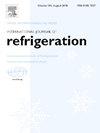Performance evaluation of ejector-enhanced and gas-bearing-assisted vapor compression chilled water system
IF 3.5
2区 工程技术
Q1 ENGINEERING, MECHANICAL
International Journal of Refrigeration-revue Internationale Du Froid
Pub Date : 2025-03-14
DOI:10.1016/j.ijrefrig.2025.03.009
引用次数: 0
Abstract
The centrifugal compressor with gas bearings is an important research direction of chiller, but the essential additional gas cycle for bearing and motor cooling still lead to the energy waste. Using an ejector to increase this gas pressure by recovering the energy of expansion process for inter-stage replenishment is a feasible solution. In this paper, a mathematical model of EGVC system (ejector-enhanced gas-bearing-assisted vapor compression chilled water system) is established and simulated comparing to the BGVC system (basic gas-bearing-assisted vapor compression chilled water system), and the performance under variable working conditions is obtained by 4E (energy, exergy, economic, environmental) analysis method. The results indicate that the ejector can reduce power consumption for gas compression and improving system performance. The COP increases while the exergy efficiency decrease with the evaporating temperature for both systems, but they show opposite changes with condensing temperature. Comparing to BGVC, the COP of EGVC increases by 1.29 %-1.52 % and the exergy efficiency increases by 1.02 %-1.21 % when the evaporating temperature rises from 1 °C to 9 °C, while they increase by 1.41 %-1.63 % and 1.12 %-1.31 % when the condensing temperature increases from 40 °C to 48 °C. The EGVC system is more suitable to the large bearing gas condition, and the COP and exergy efficiency improve by 1.49 %-2.20 % and 1.19 %-1.67 % when the proportion of gas for bearing to the total refrigerant rises from 1 % to 2 %. The cost and carbon emission of system also be reduced by using the ejector.
喷射器增强和气体轴承辅助蒸汽压缩冷冻水系统性能评价
带气体轴承的离心式压缩机是冷水机的一个重要研究方向,但轴承和电机冷却所必需的附加气体循环仍然导致能源浪费。利用喷射器回收膨胀过程的能量来提高气体压力进行级间补充是一种可行的解决方案。本文建立了EGVC系统(喷射器增强型气轴承辅助蒸汽压缩冷冻水系统)的数学模型,并与BGVC系统(基本型气轴承辅助蒸汽压缩冷冻水系统)进行了对比仿真,采用4E (energy, exergy, economic, environmental)分析方法得到了EGVC系统在变工况下的性能。结果表明,该喷射器可以降低气体压缩的功耗,提高系统性能。两者的COP随蒸发温度的升高而升高,火用效率随冷凝温度的升高而降低。与BGVC相比,当蒸发温度从1℃升高到9℃时,EGVC的COP提高了1.29% ~ 1.52%,火用效率提高了1.02% ~ 1.21%,当冷凝温度从40℃升高到48℃时,COP和火用效率分别提高了1.41% ~ 1.63%和1.12% ~ 1.31%。EGVC系统更适合大含气量工况,当含气量占总制冷剂的比例由1%提高到2%时,COP和火用效率分别提高1.49% ~ 2.20%和1.19% ~ 1.67%。采用喷射器,降低了系统的成本和碳排放。
本文章由计算机程序翻译,如有差异,请以英文原文为准。
求助全文
约1分钟内获得全文
求助全文
来源期刊
CiteScore
7.30
自引率
12.80%
发文量
363
审稿时长
3.7 months
期刊介绍:
The International Journal of Refrigeration is published for the International Institute of Refrigeration (IIR) by Elsevier. It is essential reading for all those wishing to keep abreast of research and industrial news in refrigeration, air conditioning and associated fields. This is particularly important in these times of rapid introduction of alternative refrigerants and the emergence of new technology. The journal has published special issues on alternative refrigerants and novel topics in the field of boiling, condensation, heat pumps, food refrigeration, carbon dioxide, ammonia, hydrocarbons, magnetic refrigeration at room temperature, sorptive cooling, phase change materials and slurries, ejector technology, compressors, and solar cooling.
As well as original research papers the International Journal of Refrigeration also includes review articles, papers presented at IIR conferences, short reports and letters describing preliminary results and experimental details, and letters to the Editor on recent areas of discussion and controversy. Other features include forthcoming events, conference reports and book reviews.
Papers are published in either English or French with the IIR news section in both languages.

 求助内容:
求助内容: 应助结果提醒方式:
应助结果提醒方式:


